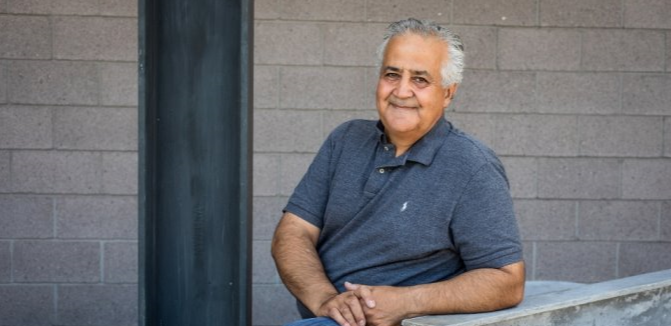Source: AZ Big Media
An Arizona State University engineering professor is trying to promote a method of speeding up the Valley’s endless construction projects that can reduce years to months and months to weeks. Transportation experts say the economic, safety and transit benefits could be huge.
Barzin Mobasher’s magic bullet is made of fiber-reinforced concrete. Mobasher and his team have come up with a certain set of calculations engineers can use to simplify working with the material.
Annually, worldwide, 10 billion tons of concrete are used: more than one ton for every man, woman and child on the planet. It’s the cheapest material that can be used in construction of roads, buildings and other things.
Designs have revolved around the fact that although concrete can withstand a lot of compression, it can’t withstand a lot of tension. Put weight on it and it’s fine. Pull it apart and it breaks. Traditionally, overcoming this flaw has meant putting steel rebar in the concrete. Engineers assume the steel will carry the load the concrete is supposed to take. They completely ignore the issue of tension.
“Almost every structure you see — every building, every skyscraper, every bridge — is based on that assumption; don’t take any contribution of concrete in tension,” said Mobasher, a professor in the School of Sustainable Engineering and the Built Environment in the Ira A. Fulton Schools of Engineering.
Composites have been around for 60 or 70 years. You mix fibers of steel or composites into a carrier (like concrete or epoxy) — typically 40 pounds of fibers in 2,000 pounds of concrete. These are very strong fibers, but also very small. When you decrease the size of something, you decrease the size of flaws that can occur in the structure.
If the concrete tries to crack, the fibers intercept the crack and act like internal Band-Aids. They hold it together and allow it to carry more of a load. It’s an interlocking mechanism.
If you’re building a five-story building, each story has to be designed and built one at a time. Rebar has to be craned in, laid out and tied together. You have material costs, inspection, labor, logistics, safety issues and so on when rebar is involved. Add up those costs and they’re significant.
Now take rebar out of the equation. If you’re only using fibers, you tell the mixing plant how much and what kind of fiber you wanted mixed into each truckload.
“This way you eliminate a lot of the side costs,” Mobasher said. “You’re paying more for the material on a pound-by-pound basis to be using fibers, but you’re saving so much on all these extra costs.”
Mobasher decided to do a proof-of-concept experiment in his lab. He made a slab of fiber-reinforced concrete and stress-tested it in a special machine. The parameters were: a line operating seven days a week, 18 hours per day, a three-car train packed to capacity coming along every 10 minutes for 40 years. There was one catch: In the experiment, water has eroded everything from underneath the beam, leading it to carry all the weight on its own.
Despite cracking, the demonstration showed that fiber-reinforced concrete can go through 2 million cycles of train traffic. And a crack would not derail an entire system. Cut out the cracked section, repour, and it’s fixed.
“Basically, we offer a solution to reduce the cost, to reduce the weight, to make the material much more ductile, earthquake-resistant, tolerant from a corrosion point of view — so a whole series of added benefits we would get,” Mobasher said.
Read more at AZ Big Media.

